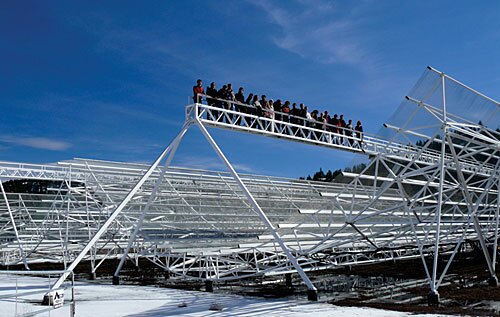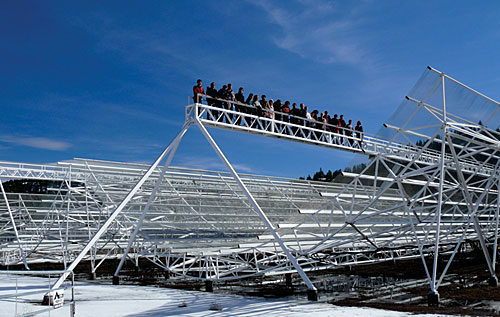Canada CHIMEs in on dark energy
DOI: 10.1063/PT.3.2476
What is the expansion history of the universe? That is what the Canadian Hydrogen Intensity Mapping Experiment (CHIME) is designed to determine. Located at the Dominion Radio Astrophysical Observatory about 400 km northeast of Vancouver, British Columbia, CHIME is slated to begin operating in late 2015.
Unlike other approaches to mapping the structure of the universe as a function of time (see, for instance, the article by Josh Frieman in Physics Today, April 2014, page 28
CHIME will consist of five parallel, parabolic, cylindrical, mesh reflectors, each 100 m long and 20 m wide. The mesh cells are a couple of centimeters across; the design withstands rain, prevents snow accumulation, is cheaper than a solid surface, and works like a mirror for the 37- to 75-cm radio wavelengths of interest. CHIME has no moving parts; with axes aligned north–south, the experiment will sweep the sky day and night as Earth rotates. The focal line for each trough will be fitted with 256 receivers. “The backend computations are a real challenge,” says Keith Vanderlinde of the University of Toronto, whose group is building an onsite correlator to perform digital interferometry. He is one of the experiment’s nine co-investigators.
The experiment is being built for less than Can$12 million (roughly $11 million). The Canadian Foundation for Innovation is putting in 40% of the funding, another 40% comes from provincial agencies, and universities and industry are providing 20%.
Commercial components
It’s possible to build CHIME at that low price, and to deal with the vast amounts of data it will produce, thanks to the huge global demand for cell phones and video games. Cell phones have driven the development of quiet, room-temperature amplifiers. The signal from every feed, or receiver, has to be amplified. Historically, the high cost of cryogenic cooling made a single-dish design, with only one receiver, advantageous, says Vanderlinde. “We can now amplify signals from each feed independently and collect the data from the distributed system.”
For number crunching, CHIME exploits the development of graphics processing units (GPUs), which for linear algebra are cheaper and faster than central processing units. “We buy top-end, off-the-shelf graphics cards. Instead of generating fancy graphics, we convert signals to images that we add up over time,” says Vanderlinde. The underlying operation is to multiply matrices. “That’s how to project from three dimensions to two dimensions, as is done in video games. But it’s also how to run correlations to form images of the sky. Mathematically, they’re the same operation.”
Each of CHIME’s 1280 receivers—256 on each of the 5 reflectors—records radio waves about a billion times a second. In total, the data will roll in at terabytes per second. The data are digitized, transformed into frequency space, and juggled in real time to be fed to the GPUs.
“A gnat’s eyelash”
Since last fall the CHIME team has been testing data collection and computation on a smaller version of the experiment. The “pathfinder” is made up of two reflectors 36 m in length. The main challenge is to subtract out the signals from our own galaxy. “What we have on our side,” says Kris Sigurdson of the University of British Columbia, who does data analysis and interpretation, “is that we understand the physics that generates the foreground. It comes from synchrotron emission, which is smooth as a function of frequency, so we think it’s possible to distinguish it from the 21-cm signals.”

This pair of radio antennas is the warm-up for the Canadian Hydrogen Intensity Mapping Experiment. CHIME team members have climbed up to a platform at the focal line of one of the reflectors.
MARK HALPERN

Miguel Morales of the University of Washington is not involved in the experiment, but uses the 21-cm line to look further back in time to the epoch of reionization. “CHIME is trying to do something new,” he says. “They have to get everything right. And they have to understand their instrument to a gnat’s eyelash. That precision makes it hard. But the payoff is huge.”
One payoff would be to see if general relativity holds on cosmological scales. Another big question that CHIME is poised to get at is whether dark energy is a cosmological constant—that is, does its density remain constant as the universe expands? Other experiments have glimpsed earlier and later times. But, says Matt Dobbs of McGill University, “there is a key gap when dark energy went from inconsequential to dominant. I want to see if that follows Einstein’s cosmological constant.”
Heavenly sound
China has a similar 21-cm survey experiment in the works. At its envisioned full size, Tianlai (Chinese for “heavenly sound”) will have the same dimensions as CHIME. A remote, radio-quiet site in Xinjiang province in northwestern China has been chosen, but construction hasn’t yet started. The project so far has around $2 million from the country’s Ministry of Science and Technology, the Chinese Academy of Sciences, and the National Astronomical Observatory, says Xuelei Chen, a cosmologist at the observatory. “We are scaling Tianlai by the amount of funding we get.” The plan is to start with a pilot project of three antennas, each 40 m long and 15 m wide.
A slew of other experiments aimed at decoding dark energy are at various stages of proposal and planning. Euclid, a satellite that the European Space Agency plans to launch in 2020, will probe the expansion history of the universe and the evolution of cosmic structures. The Hobby-Eberly Telescope Dark Energy Experiment at the McDonald Observatory in west Texas is set to start a galaxy survey later this year using emission lines from ionized hydrogen to pinpoint individual galaxies. When the Square Kilometre Array gets going in South Africa and Australia, it will dwarf CHIME in sensitivity—but that’s still years away (see the story on page 25
Not much is known about dark energy, says Morales, “so you want to measure the size of the universe at several different ages, and then let the theorists fight it out. I think CHIME has a good chance of being the first to get really good measurements.” And, although CHIME was conceived as a single-purpose experiment, inroads are anticipated in other areas, such as pulsars, gravity at large scales, galaxies, and fast radio bursts.
More about the Authors
Toni Feder. tfeder@aip.org
